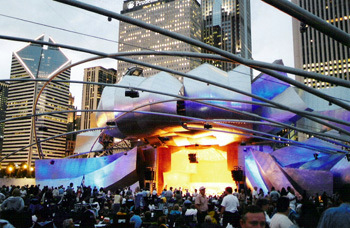Arts and Culture Scenario Outcome

Chicago is notable for its rich legacy of cultural and artistic achievement, ranging from the 1893 Columbian Exposition to its current bid for the 2016 Summer Olympics, in addition to the wide variety of world-renown cultural enterprises such as the Art Institute of Chicago and the Chicago Symphony Orchestra.
An increase in arts participation is included as a part of the GO TO 2040 plan, as the arts and culture of Chicago are made more accessible and affordable for the citizens of Chicago over the next thirty years.
In coordination with an advisory committee of regional experts, the Illinois Arts Alliance has prepared general recommendations for actions to improve arts and culture within the long-term context of the GO TO 2040 plan. These recommendations cover:
- Diversity
- Presence of arts and culture
- Participation in the arts
- Support for the arts
- Arts education
- Advocacy
A report that provides more details on these recommendations is forthcoming and will be posted in this space when available; an executive summary is currently available.
Effect of physical planning decisions on arts and culture
The purpose of the questions below is to understand how today's planning policy and investment decisions – covering transportation, land use, housing, economic development, and the natural environment – might affect arts and culture in our region in 2040.
How would arts and culture be affected by different economic development policies: focusing on investments in human capital (improving the region's workforce); infrastructure (investing in physical infrastructure such as Transportation facilities); or innovation (including but not limited to technological innovation)?
- Investments in human capital would likely include support for arts and culture. A strong network of arts and culture organizations would make the region more attractive to highly skilled workers, who are needed for many of these industries. In particular, places with cultural amenities are shown to be able to attract "creative" and high-tech workers and businesses. Many skilled workers, particularly those in technology fields, may be interested in less traditional arts institutions and forms of arts and culture consumption.
- Physical infrastructure is also needed to support the arts, which benefits from well-designed public spaces and mixed land uses.
- The ability of arts and culture to drive innovation is significant, and there are substantial clusters of arts-related industries in the region, including architecture, film, graphic design, advertising, and fashion. However, more alignment between commercial and non-commercial arts sectors would be needed to support this even further.
- The effect of new technology on arts and culture is mixed – there are both opportunities and challenges in reconciling arts and culture systems with new technological advancements.
How would arts and culture be affected by different transportation investment alternatives: focusing on major infrastructure investments (road or rail expansions); low-capital operational improvements (improved bus service, sidewalks, and trails); or technology (including real-time information or improved traffic signal timings)?
- The type of improvement is not critical, as long as it improves access to arts institutions, particularly in congested areas. High parking costs or infrequent transit service can reduce access to arts and culture, especially among older patrons; this should be considered in planning transportation improvements.
How would arts and culture be affected by different land use policies: focusing on dense, infill development; moderate densities with emphasis on community-centered design; or low-density new development?
- Density of development is less important than providing space to support for arts and culture activities. To support arts and culture, informal arts activities and classes should be permitted by land use and zoning policies, as should permitting artists to use their homes as workplaces and studios. Land use planning should also consider the benefits of the visual presence of arts within communities, and make provisions for public art. Mixed, diverse land uses are also supportive of arts and culture.
- Historic preservation also supports arts and culture, especially when preservation activities highlight the cultural implications of history. Also, an appropriate adaptive reuse of historic buildings can often be artist live-work space.
How would arts and culture be affected by different land conservation policies: focusing on preserving large areas open space for biodiversity; providing parks for community access; or providing open space as part of new development?
- Parks are often sites for informal arts and culture events, and increasing the access of people to these facilities would improve the arts and culture system. Having dispersed locations, easy and free access, and a variety of types of spaces within parks also supports informal arts and culture.
How would arts and culture be affected by energy policies: focusing on adopting clean energy sources; reducing the energy consumption of buildings; or reducing the energy consumption of the transportation system?
- Many arts and culture institutions are not energy-efficient, and retrofits would significantly reduce their energy expenditures.
How would arts and culture be affected by housing policies: preserving existing affordable housing; creating new affordable housing near transit and jobs; or reducing housing costs through energy efficiency improvements?
- Providing affordable housing in mixed-income, mixed-use developments supports arts and culture, as it can provide housing options for artists.